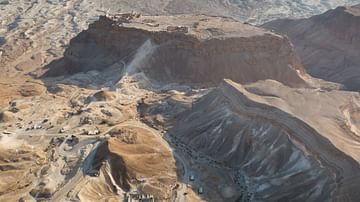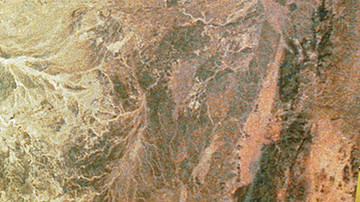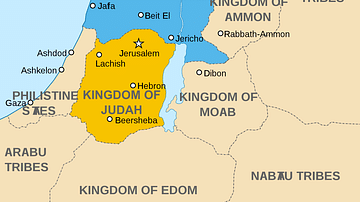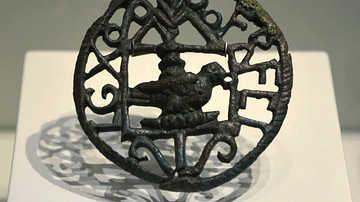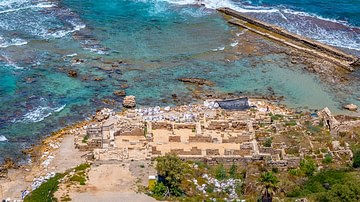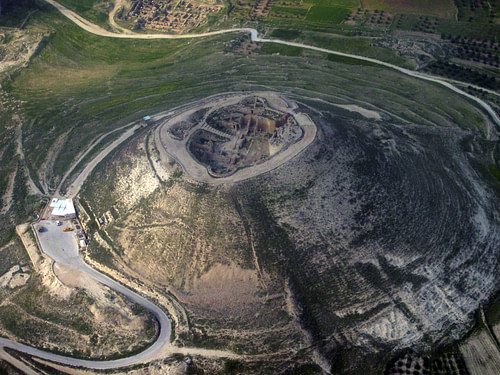
Herod I, or Herod the Great (c. 75 – 4 BCE), was the king of Judea who ruled as a client of Rome. He has gained lasting infamy as the 'slaughterer of the innocents' as recounted in the New Testament's book of Mathew. Herod was, though, a gifted administrator, and in his 33-year reign, he was responsible for many major building works which included a rebuilding of the Temple of Jerusalem, several aqueducts, and the massive fortress known as the Herodium. Historians have re-assessed his long-held negative reputation and now credit his reign as having had at least some positive effects on Jews and Judaism in his kingdom.
Accession to the Throne
Herod was a client king (or close ally) of Rome, but his route to the throne was not a straightforward one. His father Antipater the Idumaean made him governor of Galilee in 47 BCE. On the death of his father, there followed a turbulent period of in-fighting involving his brother and various Roman factions. In 40 BCE the Parthians attacked both Syria and Palestine, taking Jerusalem in the process. Herod's brother was taken captive, and he committed suicide shortly after. Herod was thus forced to flee to Rome, and Antigonus of the Hasmonean dynasty was installed as ruler at Jerusalem.
In Rome Herod gained the favour of Octavian and Mark Antony, with whose support the Senate was persuaded to install Herod as the king of Judea. In practical terms, though, this did not solve the problem of Antigonus and the Parthians. Mark Antony was therefore dispatched to the region and he swiftly cleared it, forcing the Parthians back to the eastern side of the Euphrates River. Meanwhile, Herod, with the aid of the Roman general Gaius Sosius, led a force and retook Jerusalem in 37 BCE. Finally, he began what would be a long and prosperous 33-year reign as king of Judea, or 'the land of the Jews' as it was often referred to.
Consolidating Power & Expansion
According to the 1st-century CE Roman historian Josephus, the early years of Herod's reign were not helped by a rivalry with Cleopatra VII. Her consort Mark Antony was, in effect Herod's patron, but the Egyptian queen constantly nibbled away at some of the most lucrative parts of Herod's kingdom. With Octavian's victory at Actium in 31 BCE, which ended Antony and Cleopatra's influence, Herod forged a useful new partnership with Rome's soon-to-be first emperor.
Herod's reign was largely a peaceful one, and although he gained a reputation for imposing oppressive taxes, in fact, these were not excessive and no worse than contemporary regimes. Neither was Herod obliged to pay tribute to Rome, although he did send handsome gifts. By 30 BCE he had regained control of all the territories that the Hasmoneans and Cleopatra had taken. Then between 23 and 20 BCE he expanded his realm into northern Galilee and repopulated certain areas with sympathetic settlers. A gifted administrator, he created a new priestly class (abolishing the hereditary qualification for office) and a more multicultural elite. He also gave Judea a greater standing in the Mediterranean world via his extravagant gifts to Athens and patronage of the still important Olympic Games.
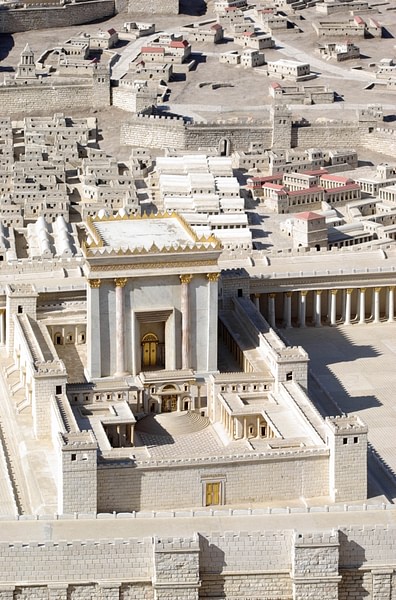
Building Programme
Now firmly established in his kingdom, Herod embarked on a series of grand building projects, possibly funded by a half-shekel tax payable by each Jew in the Diaspora. The programme also created employment and stimulated the economy, although it is debatable how much the Jewish population benefitted from this in the long-term. The most famous project was a lavish refurbishment of the temple of Jerusalem. Herod also expanded the same city's fortification walls and added a theatre and amphitheatre. He improved several fortresses (notably those at Jericho and Masada on the western shore of the Dead Sea), rebuilt Samaria (renaming it Sebaste, Greek for Augustus in the feminine), and constructed a new harbour at Strato's Tower (Caesarea Maritima). Both of the latter renamings highlight Herod's eagerness to please his Roman allies. Perhaps the most ambitious of Herod's projects was the Herodium fortress 11 km south of Jerusalem.
The Herodium
The Herodium fortress, one of seven built by Herod, has been identified by archaeologists as the Jebel Fureidis mountain on the edge of the Judean desert. The classic cone-shaped mountain was an ideal location for the fortress which Herod built to commemorate his victory over Antigonus and the Parthians in 37 BCE. The fortress was to provide Herod with a place of refuge if his rule were ever challenged and, perhaps too, act as his mausoleum. It was built by digging out the peak of the mountain and using the recovered earth as part of the ramparts. A large palace was built within its walls which was supplied with water by a system of aqueducts. The whole complex was completed c. 15 BCE. At the base of the mountain a small town was constructed, which included administrative buildings, gardens, a synagogue, mausoleums, and a large pool. The site has been excavated, and highlights include the large pool of the lower town and one of the earliest Roman domed roofs inside the palaces baths.

Later Reign
The reign of Herod became more troubled the longer it lasted. In 9 BCE a war broke out with Nabataea, Herod's southern neighbours, which had become a base for Judean opposition factions. The situation worsened when Augustus initially sided with the Nabataeans in the dispute. Fortunately, Herod's envoy, Nicolaus of Damascus, was able to present the king's case, and Augustus changed policy.
As well as diplomatic problems Herod had family issues to deal with, too. Suspecting his wife Mariamne of being unfaithful he had her executed in 29 BCE. Their two sons were suspected of loyalties to the opposition threatening Herod from Nabataea, and so Herod ruthlessly dispatched them c. 6 BCE, along with his eldest son Antipater two years later. By now, though, the ageing king was suffering severe health problems which affected his internal organs, and he died in 4 BCE. Herod was buried in a purpose-built tomb on the slopes of the Herodium. In 2007 CE this tomb was excavated, but the sarcophagus within it was damaged and empty. Probably it had been opened during the first Jewish Revolt in the century after Herod's death. Herod's kingdom was divided by the Romans between Herod's three sons: Herod Antipas, Archelaus, and Philip.
The New Testament
Herod's lasting reputation and infamy rest largely on his depiction in chapter 2 of Mathew in the New Testament. Here Herod is informed by wise men from the east that a King of the Jews would be born in Bethlehem. The king then sent these men "to Bethlehem, and said, Go and search diligently for the young child; and when ye have found him, bring me word again, that I may come and worship him also" (Mathew 2: 8). Then, on finding the child and presenting to him gifts, the wise men "being warned of God in a dream that they should not return to Herod" (ibid 2:12) decided not to follow Herod's wishes. Next, "the angel of the Lord appeareth to Joseph in a dream, saying, Arise, and take the young child and his mother, and flee into Egypt, and be thou there until I bring thee word: for Herod will seek the young child to destroy him" (ibid 2:13). This Joseph did, and when Herod discovered it, "when he saw that he was mocked of the wise men, was exceeding wroth, and sent forth, and slew all the children that were in Bethlehem, and in all the coasts thereof, from two years old and under" (ibid 2:16).
This presentation should perhaps be considered with the evidence that Herod, as the historian L. L. Grabbe states, "lived as a Jew and generally respected Jewish religious law" and that, although there were undoubtedly some negative aspects to his reign, "His connections also allowed him to be useful to the Jews on several occasions, and on the whole his reign was beneficial to the Jewish people and religion" (Bagnall, 3175). Nevertheless, the historian S. Schwart perhaps best sums up the complexities of Herod's position as mediator between Rome, the Jews, opposing family factions, and the non-Jewish citizens within his realm by stating that "it is impossible to provide an unambiguous evaluation of Herod's reign" (Barchiesi, 770).

